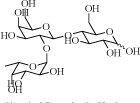HMO是一类独特的、天然存在于母乳中的碳水化合物,是母乳中2'-岩藻糖基乳糖 简称2’-FL最富集的营养成分。
人乳寡糖HMOs系列,Human Milk Oligosaccharides
人乳寡糖Human Milk Oligosaccharides是一类自然存在于人乳中的复杂混合低聚糖,上海惠诚生物提供人乳寡糖(HMOs)系列产品
上海惠诚生物提供人乳寡糖系列产品,更多寡糖,多糖产品,请联系021-60498804,我们竭诚为您提供各类糖产品。
Human breast milk provides the primary source of nutrition for newborns before they are able to eat and digest other foods. One distinctive property of human milk from most other species is the amount and diversity of the free oligosaccharide it contains. These human milk oligosaccharides (HMO) can be present at levels of up to 12 g/l in milk and up to 20 g/l in colostrum.1 HMO have been attributed with a variety of functions including:
1) Prebiotic
2) Decoy carbohydrate
3) Immunomodulation
HMO Structure
Currently at least 130 unique HMO have been identified, all differing by constituent sugars, molecular weight or structure. Many share a common motif characterized by repetitive attachment of galactose (Gal) and N-acetylglucosamine (GlcNAc)2 in a b-glycosidic linkage to lactose. Additional variety is generated by the addition of fucose (termed neutral HMO), e.g. 3'-Fucosyllactose, (05673) or 2-Fucosyllactose, (06739) and sialic acid (termed acidic HMO), e.g. 6'-Sialyllactose, (04398) and 3'-Sialyllactose, (04397). Addition is via a-glucosidic bonds to generate oligosaccharides from three to thirty two sugars in length. Whilst most of the biosyntheis of HMO is not controlled at the gene level (unlike proteins) the presence and position of fucosylation is governed by the Lewis/Secretor status of the mother.3
Dominant neutral oligosaccharides have been identified as lacto-N-tetraose (05683), lacto-N-neotetraose (05765) and lacto-N-fucopentaose I and V (05676 and 06817 respectively)4
Prebiotic Properties of HMO
The most abundant HMO is lacto-N-tetraose which is able to survive the acid environment of the stomach and is not degraded by normal gut enzymes. It therefore can pass down to the lower intestine where it acts as a prebiotic which encourages lower gut colonisation by many bifidobacteria species, which are recognised as essential for normal gut function.5
HMO as Decoy Carbohydrates
Binding to a host cell wall is critical for the virulence of many pathogenic bacteria including Campylobacter jejuni, E.coli, Vibrio cholera, and Shigella and some Salmonella strains. Many of the virulence factors of these organisms are carbohydrate-binding proteins (lectins) which bind sugars displayed on cell membranes. HMO can bind to these lectins acting as decoys and preventing pathogens from sticking to the target cells. An example of this is the inverse relationship between the incidence of C. jejuni, (one of the most predominant causes of diarrhoea in the world) in breast-fed children and levels of 2-fucosyl-lactose in the mother’s milk. (C. jejuni is known to adhere to intestinal 2-fucosyl-lactosamine).6 Similar antimicrobial effects of HMO have also been demonstrated for calicivirus diarrhoea and infections with heat stable enterotoxin of E. coli.7
During ingestion, HMO coat the throat and are known to inhibit adhesion of Streptococcus pneumoniae and Haemophilus influenzae to human pharyngeal or buccal epithelial cells resulting in the lower incidence of otitis media (inner ear infection) in breast fed babies.8
Immune Role of HMO
Selectins are glycoproteins which are displayed on the surface of many cells of the immune system and are involved with cell/cell interactions such as the infiltration of tissues in inflammation. Selectins bind to specific fucosylated and sialylated oligosaccharides, e.g., sialyl Lewis x (sLex, 04058), on their respective target ligands. HMO share many structural similarities to these carbohydrate ligands and acidic (sialylated) HMO are able to inhibit rolling and adhesion of leucocytes at physiologically relevant concentrations.
One of these selectin interactions is the formation of platelet/neutrophil complexes (PNCs) which lead to the activation of the neutrophils. PNCs are thought to be involved in necrotizing enterocolitis (NEC) and HMO have been attributed as the agent responsible for the lower incidence of NEC in breast fed infants (85 % lower than formula fed infants) via inhibition of PNC formation.9
Fractions of HMO are also known to inhibit the binding of both Galectins which bind b-Gal and LAcNAc terminated glycans and Siglecs which are specific for terminal sialic acid, their role in immunity or development however has not yet been fully explored.10,11







